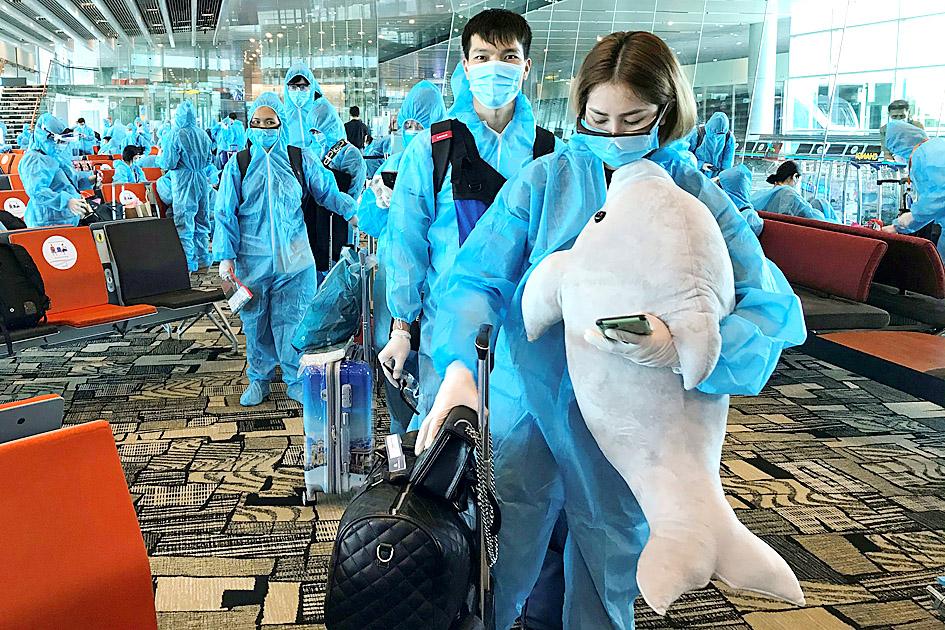The cost of air tickets between two major Asian financial hubs jumped within 24 hours of Singapore and Hong Kong unveiling plans for a travel bubble that would not require people to quarantine upon arrival.
The cheapest price for a Singapore Airlines Ltd return economy seat to Hong Kong yesterday morning was S$558 (US$410) up until the end of December, versus around S$400 Thursday afternoon as the news was announced, the airline’s website showed. Return business-class fares rose about HK$5,000 (US$645) to HK$19,000. Cheaper flights were still available on travel Web sites including Skyscanner Ltd.
The COVID-19 pandemic has hit the flag carriers of Singapore and Hong Kong especially hard as they do not have any domestic market to fall back on. Prior to the pandemic, around 1 million trips were made between the two regional centers every year, data from the Singapore and Hong Kong tourism boards showed.

Photo: Reuters
Hong Kong-listed Cathay Pacific Airways Ltd closed up 6.1 percent on Thursday and yesterday rose as much as 6.4 percent as investors digested the news. The agreement could lift Cathay’s monthly revenue by HK$90 million and reduce cash burn by as much as 6 percent, said Bloomberg Intelligence analysts James Teo and Chris Muckensturm, who assume revenue on the Hong Kong to Singapore route amounted to about 3 percent of Cathay’s total pre-pandemic.
Singapore Airlines, which yesterday rose as much as 1.4 percent, could see a S$15 million boost to monthly revenue and 6 percent reduction in cash burn, Teo and Muckensturm said. The route also made up about 3 percent of its revenue before COVID-19, they said.
The number of flights between Hong Kong and Singapore slumped, with only 54 round trips filed this month, down 90 percent from a year earlier, aviation analytics company Cirium said.
“Although the travel bubble will potentially facilitate increase of services by Cathay Pacific, Singapore and Scoot, who have continued to operate minimal services on the route through 2020, demand is expected to remain depressed in the near-term as passenger confidence remains low,” said Herman Tse, an analyst at Cirium.
Still, the bubble plan has encouraged some to book flights or make plans to travel. Singapore-based Clarence Foo, who works for APAC Realty Ltd unit ERA, said that four Chinese with Hong Kong residency had told him that they planned to fly down to the city-state and purchase luxury apartments.
“They’re constantly asking about the property market — whether it’s recovering and whether prices are coming up,” Foo said. “Some had planned to come down earlier in the year, but then Singapore imposed border controls. They know that the city’s property market seems to be more resilient now as there have been more sales and prices are low, so they want to capitalize on that.”
Under the travel bubble, compulsory quarantine would be replaced by COVID-19 testing. Singaporean Minister of Transport Ong Ye Kung (王乙康) said he hopes that the bubble would start in “weeks.” Other details of the agreement would be fleshed out later, the Hong Kong government said, without giving any date for when the plan would come into effect.
Singaporean Victoria Ho used to travel from Hong Kong back home to Singapore every month. After a hiatus, she is back on a plane this weekend. Although the bubble has not kicked in, she welcomed the announcement, saying it would allow friends to visit.
“I’ll be able to pop home to meet with coworkers and clients, because I do have meetings I’d like to make there,” she said.
Tan Wei Lynn, who works in the financial sector in Hong Kong, booked her ticket to Singapore soon after the announcement. She plans to stay for several weeks and not fly back to Hong Kong until December, assuming that there would be more details laid out by then.
“Having to quarantine is what’s stopped me, and a lot of people I know, from traveling,” Tan said. “Yes, tests are expensive, but it’s not about the cost of testing. We can’t afford to quarantine at one side or both sides.”

To many, Tatu City on the outskirts of Nairobi looks like a success. The first city entirely built by a private company to be operational in east Africa, with about 25,000 people living and working there, it accounts for about two-thirds of all foreign investment in Kenya. Its low-tax status has attracted more than 100 businesses including Heineken, coffee brand Dormans, and the biggest call-center and cold-chain transport firms in the region. However, to some local politicians, Tatu City has looked more like a target for extortion. A parade of governors have demanded land worth millions of dollars in exchange

An Indonesian animated movie is smashing regional box office records and could be set for wider success as it prepares to open beyond the Southeast Asian archipelago’s silver screens. Jumbo — a film based on the adventures of main character, Don, a large orphaned Indonesian boy facing bullying at school — last month became the highest-grossing Southeast Asian animated film, raking in more than US$8 million. Released at the end of March to coincide with the Eid holidays after the Islamic fasting month of Ramadan, the movie has hit 8 million ticket sales, the third-highest in Indonesian cinema history, Film

Taiwan Semiconductor Manufacturing Co’s (TSMC, 台積電) revenue jumped 48 percent last month, underscoring how electronics firms scrambled to acquire essential components before global tariffs took effect. The main chipmaker for Apple Inc and Nvidia Corp reported monthly sales of NT$349.6 billion (US$11.6 billion). That compares with the average analysts’ estimate for a 38 percent rise in second-quarter revenue. US President Donald Trump’s trade war is prompting economists to retool GDP forecasts worldwide, casting doubt over the outlook for everything from iPhone demand to computing and datacenter construction. However, TSMC — a barometer for global tech spending given its central role in the

Alchip Technologies Ltd (世芯), an application-specific integrated circuit (ASIC) designer specializing in server chips, expects revenue to decline this year due to sagging demand for 5-nanometer artificial intelligence (AI) chips from a North America-based major customer, a company executive said yesterday. That would be the first contraction in revenue for Alchip as it has been enjoying strong revenue growth over the past few years, benefiting from cloud-service providers’ moves to reduce dependence on Nvidia Corp’s expensive AI chips by building their own AI accelerator by outsourcing chip design. The 5-nanometer chip was supposed to be a new growth engine as the lifecycle